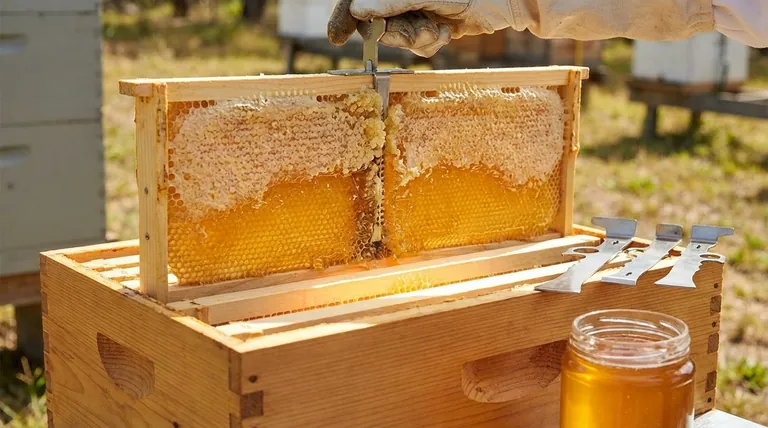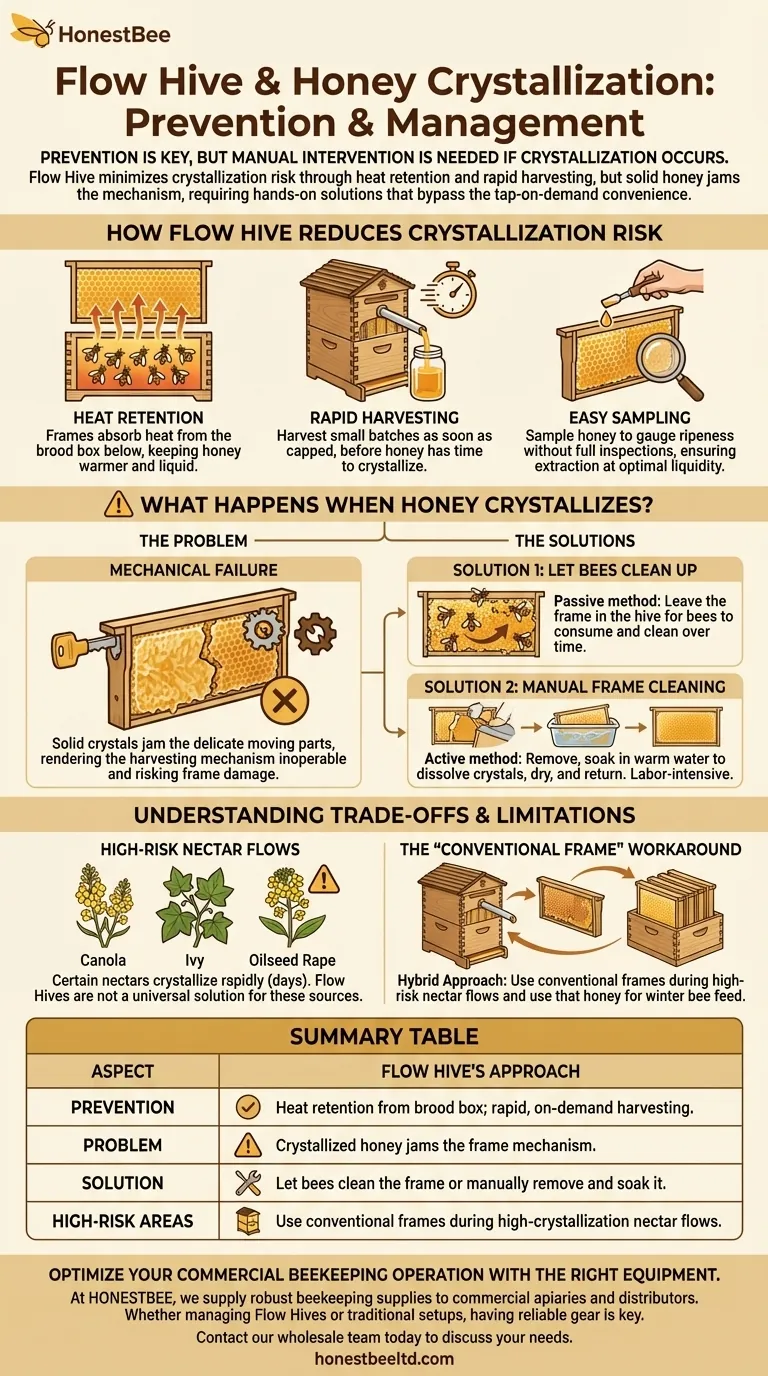In short, the Flow Hive primarily handles honey crystallization through preventative design features, but if crystallization does occur, it requires manual intervention that bypasses the system's main convenience. The frames are designed to retain heat from the brood box and allow for rapid harvesting, both of which reduce the likelihood of honey solidifying in the comb.
The Flow Hive is engineered to minimize the risk of honey crystallization, not eliminate it. While its design offers distinct advantages for prevention, dealing with honey that has already crystallized requires specific, hands-on solutions that temporarily negate the "tap-on-demand" benefit.

How the Flow Hive Reduces Crystallization Risk
The system's core design incorporates features aimed at keeping honey in a liquid state, addressing the root causes of crystallization before it becomes a problem.
The Role of Heat Retention
Honey crystallizes fastest in a specific temperature range, typically between 10°C and 18°C (50°F and 65°F).
The Flow Frames are positioned directly above the brood box, allowing them to absorb radiant heat from the bee cluster below. This helps keep the honey stored in the frames at a warmer, more stable temperature, reducing the chance of it solidifying.
The Advantage of Rapid Harvesting
The Flow Hive's signature feature is its quick and minimally disruptive harvesting process. This is a significant advantage when dealing with nectar prone to rapid crystallization.
Because you can drain honey directly into a jar, you can harvest small batches as soon as they are capped. This allows you to extract the honey before it has sufficient time to crystallize within the hive.
The Benefit of Easy Sampling
Traditional hive inspections to check honey readiness are disruptive and time-consuming. The Flow Hive allows you to sample a small amount of honey from the frame without a full inspection.
This lets you accurately gauge when the honey is "ripe" and ready for harvest, ensuring you extract it at the perfect moment for optimal quality and liquidity.
What Happens When Honey Crystallizes in the Frame?
If prevention fails, crystallized honey will jam the delicate inner workings of the Flow Frame, rendering the harvesting mechanism inoperable.
The Mechanical Failure
The Flow Hive works when a Flow Key is turned, vertically offsetting the two halves of the plastic comb. This movement breaks the wax cappings and creates channels for the honey to flow down.
If the honey cells are filled with solid sugar crystals, the parts cannot move. Forcing the key in this situation can damage the frame.
Solution 1: Letting the Bees Clean Up
The most passive solution is to simply leave the frame in the hive. Over time, the bees will consume the crystallized honey, cleaning out the cells themselves.
This method requires no work from the beekeeper but means the frame is out of commission until the bees have finished the cleanup.
Solution 2: Manual Frame Cleaning
For a faster solution, you must remove the affected frame from the hive entirely. The frame can then be soaked in warm water to dissolve the sugar crystals.
Once clean and dry, the frame can be returned to the hive. This is an effective but labor-intensive fix that requires opening the hive and handling frames, similar to traditional beekeeping.
Understanding the Trade-offs and Limitations
While innovative, the Flow Hive is not a universal solution for every beekeeping environment, especially those with challenging nectar sources.
High-Risk Nectar Flows
Certain plants, like canola, ivy, or oilseed rape, produce nectar that is extremely high in glucose and crystallizes very quickly—sometimes within days. In regions dominated by these plants, the risk of frame blockage is significantly higher.
The "Conventional Frame" Workaround
Many experienced Flow Hive users have adopted a hybrid approach. During high-risk nectar flows, they remove the Flow Super entirely.
They replace it with a super containing conventional frames. The honey harvested from these frames is often set aside and used as a highly nutritious winter feed for the bees, which is a better alternative than plain sugar syrup.
Making the Right Decision for Your Apiary
Understanding how the Flow Hive manages crystallization is key to determining if it fits your beekeeping goals and local environment.
- If your primary focus is maximum convenience in an area with low-risk nectar: The Flow Hive is an excellent choice, as its design inherently minimizes the risk of crystallization.
- If you are in an area with high-crystallization plants: Be prepared to harvest honey very quickly after it's capped or adopt the hybrid strategy of using conventional frames during those specific nectar flows.
- If your honey has already crystallized in a frame: Your simplest path is to let the bees manage it over time, but for a faster reset, you must remove, soak, and clean the frame manually.
Ultimately, mastering the Flow Hive involves leveraging its convenience when conditions are right and knowing when to apply traditional techniques to manage its limitations.
Summary Table:
| Aspect | Flow Hive's Approach |
|---|---|
| Prevention | Heat retention from brood box; rapid, on-demand harvesting. |
| Problem | Crystallized honey jams the frame mechanism. |
| Solution | Let bees clean the frame or manually remove and soak it. |
| High-Risk Areas | Use conventional frames during high-crystallization nectar flows. |
Optimize your commercial beekeeping operation with the right equipment.
At HONESTBEE, we supply robust beekeeping supplies and equipment to commercial apiaries and distributors. Whether you're managing Flow Hives or traditional setups, having reliable gear is key to maximizing honey yield and managing challenges like crystallization.
Let us help you equip your operation for success. Contact our wholesale team today to discuss your needs and our product catalog.
Visual Guide

Related Products
- HONESTBEE Advanced Ergonomic Stainless Steel Hive Tool for Beekeeping
- Professional Dual-End Stainless Steel Hive Tool for Beekeeping
- Long Langstroth Style Horizontal Top Bar Hive for Wholesale
- Professional 3-Bar Frame Grip with Integrated Hive Tool
- Metal Bee Hive Stand Bee Box Stand for Beekeeping
People Also Ask
- What are the basic tools for beekeeping? Essential Starter Kit for Safe & Successful Hive Management
- How should beekeepers handle bees when using a hive tool? Master Calm, Deliberate Techniques
- What are some common uses of a hive tool? Essential Multi-Purpose Tool for Every Beekeeper
- Why do hive tools have a hole? Unlock the Secret to Efficient Beekeeping
- What is the hole in a hive tool for? A Multi-Tool for Apiary Repairs and Maintenance



















